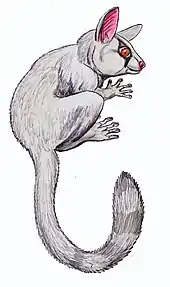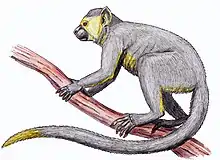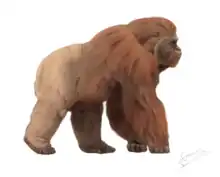| Branisella | |
|---|---|
| Scientific classification | |
| Domain: | Eukaryota |
| Kingdom: | Animalia |
| Phylum: | Chordata |
| Class: | Mammalia |
| Order: | Primates |
| Suborder: | Haplorhini |
| Infraorder: | Simiiformes |
| Family: | Cebidae (see text)[1] |
| Subfamily: | †Branisellinae (see text)[1] |
| Genus: | †Branisella |
| Type species | |
| †Branisella boliviana | |
Branisella is an extinct genus of New World monkey from the Salla Formation of what is now Bolivia during the Late Oligocene, approximately 26 million years ago (Deseadan), comprising only the species Branisella boliviana.[2][3] Together with the Peruvian genus Canaanimico, it is the oldest fossil New World monkey discovered.
Classification
Within platyrrhines, this taxon has been interpreted as either a stem platyrrhine not related to any of the living forms, or as a primitive callitrichine. One analysis shows it is sister to the clade of all non-pitheciids and should remain incertae sedis.[1] As Branisella is currently the only South American primate taxon known until the Miocene, more fossils are needed before its phylogenetic position can be clearly established.
Description
It was found in Bolivia by the paleontologist Leonardo Branisa, and it was named after him by Hoffstetter, the scientist who first described and classified it in 1969.[4] Morphologically, it is similar to Proteropithecus, an Oligocene primate from Africa, in its reduced upper second premolar and unreduced lower second premolar. This suggests the primitive platyrrhine ancestors of Branisella came to South America from Africa. Other features, however, suggest that it may have been related to the omomyids, an extinct group of tarsier-like primates found in North America, among other places.[5]
Branisella has an estimated body mass of 1,000 g (35 oz).[1] The cheek teeth of Branisella are very high-crowned, suggesting that it might have been somewhat terrestrial,[6] although this hypothesis cannot be confirmed from bones of the postcranial skeleton (there are none). The known dental specimens show extremely heavy and rapid wear and the first molar tooth is far more worn than the last, suggesting that it included abrasive foods in its diet with very poorly developed cutting edges indicating a diet of fruit.[6] One specimen retains a small part of the orbit and indicates that Branisella had small eyes and was diurnal.
References
- 1 2 3 4 Silvestro, Daniele; Tejedor, Marcelo F.; Serrano Serrano, Martha L.; Loiseau, Oriane; Rossier, Victor; Rolland, Jonathan; Zizka, Alexander; Antonelli, Alexandre; Salamin, Nicolas (2017). "Evolutionary history of New World monkeys revealed by molecular and fossil data" (PDF). doi:10.1101/178111. Retrieved 2019-02-20 – via BioRxiv.
- ↑ Branisella at Fossilworks.org
- ↑ Takai, M; et al. (February 2000). "New fossil materials of the earliest new world monkey, Branisella bolivians, and the problem of platyrrhine origins". American Journal of Physical Anthropology. 111 (2): 263–81. doi:10.1002/(SICI)1096-8644(200002)111:2<263::AID-AJPA10>3.0.CO;2-6. PMID 10640951.
- ↑ Hoffstetter MR (1969). "Un primate de l'Pliocène inférieur sudamericain: Branisella boliviana gen. et sp. nov". Comptes rendus de l'Académie des Sciences (in French). Paris. 269: 434–437.
- ↑ Palmer, D., ed. (1999). The Marshall Illustrated Encyclopedia of Dinosaurs and Prehistoric Animals. London: Marshall Editions. p. 288. ISBN 978-1-84028-152-1.
- 1 2 Kay, R.F.; Williams, B.A.; Anaya, F. (2001). "The adaptations of Branisella boliviana, the earliest South American monkey". In Plavcan, J.M.; van Schaik, C.; Kay, R.F.; Jungers, W.L. (eds.). Reconstructing Behavior in the Primate Fossil Record. New York: Kluwer Academic/Plenum Publishers. pp. 339–370.



